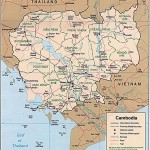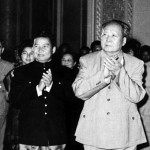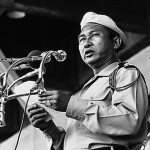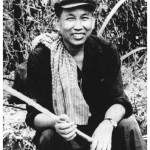
Cambodia is a small nation of some 180,000 square kilometres, lying south-west of Vietnam and also sharing borders with Thailand and Laos. By 1960 Cambodia’s population was around six and a half million people, the majority peasant farmers. Like its northern neighbour Laos, Cambodia became an unwilling battleground in the Vietnam War. During the mid 1960s its eastern regions were infiltrated and invaded by North Vietnamese and Viet Cong troops. This led to American intervention in Cambodia, most noticeably a sustained bombing campaign. In the period 1969-70, the United States dropped more bombs on Cambodia than it had used in the entirety of World War II. This foreign intervention and disruption had a profound effect on Cambodia’s development. It contributed to the rise of the Khmer Rouge, a communist paramilitary that became one of the most murderous regimes in human history.
Prior to the Vietnam War Cambodia was led by Norodom Sihanouk, a charismatic young prince with a taste for Western culture, particularly the music of Elvis Presley. Sihanouk produced his own films, organised public processions and parades, and gave long, rambling speeches on Cambodian radio. Though not short on ego, Sihanouk was both a political progressive and a nationalist who wanted the best for its people. When the French granted Cambodia independence in 1953, Sihanouk took the radical step of abdicating as king and running as a democratic candidate. His popularity saw him elected as prime minister. Though initially pro-American, Sihanouk adopted a more neutral position following American military intervention in Vietnam in 1965. This placed Sihanouk and his government in a difficult position, given Cambodia’s extensive and largely uncontrolled land borders with Vietnam. Thousands of North Vietnamese Army (NVA), Viet Cong and Cambodian communists moved freely across these borders, using Cambodia’s eastern regions for stashing supplies, taking refuge and transiting men and material to South Vietnam. Cambodian farmers also traded rice and other products with communists soldiers and revolutionaries.

The escalating conflict in Vietnam prompted the Americans to apply pressure and demand action against communists operating within Cambodian borders. Sihanouk wanted to avoid being drawn into a wider regional conflict, so sought to maintain a relatively neutral position. This led to speculation that Sihanouk was either ‘soft’ or a communist sympathiser. Relations between Phnom Penh and Washington became more difficult and began to sour. In May 1965 it collapsed altogether when Sihanouk broke off diplomatic relations with the US, a move that curtailed US aid to Cambodia. Sihanouk decided to develop a relationship with China, a nation he correctly believed would eventually dominate the Asian hemisphere. Sihanouk’s position outraged the more conservative members of his own administration, particularly his military chief, General Lon Nol. A career military officer who had worked for the French during the 1940s and early 1950s, Lon Nol was pro-American, anti-communist and a believer in authoritarian government.

In 1966 Lon Nol became prime minister, following an election marred by claims of intimidation and corruption. In 1966-67 he urged Sihanouk to crack down on communists operating in Cambodia. Eager to appear centrist, Sihanouk agreed. In March 1967, while Sihanouk was out of the country, Lon Nol sent troops into Cambodia’s western Battambang province to quell disturbances there. Hundreds were slaughtered and dozens of villages and granaries were razed. After Sihanouk’s return, Hanoi began demanding access to Cambodian territory, to transit and store NVA and Viet Cong troops and supplies. Sihanouk did not approve this – but he knew that his own military could not prevent it. Meanwhile, Cambodia’s communist insurgency – now calling themselves the Communist Party of Kampuchea (CPK) – was expanding and regrouping. In the mid-1960s the CPK contained barely a few hundred members, however, government crackdowns, corruption, military brutality and Viet Cong propaganda helped create thousands of new recruits. Sihanouk described the insurgents of the CPK as the Khmer Rouge (‘Red Khmers’) and this label was quickly picked up by the Western press.
“In October 1970 Lon Nol abolished the monarchy and proclaimed a republic, but in effect, he became the dictator of Cambodia. His administration was marked by extraordinary corruption and ineptitude, and his 1971 stroke left him unable to maintain control of the government. Pol Pot and the Khmer Rouge made steady gains in the countryside. [They] assumed a heroic stance among millions of Cambodians.”
James Stuart Olson, historian
In March 1970, Lon Nol led a coup that removed Sihanouk from power while he was out of the country. One of Lon Nol’s first steps was to contact Hanoi and demand the withdrawal of all NVA and Viet Cong forces from Cambodia. Not only was this demand ignored, the North Vietnamese mounted a series of attacks on Cambodian government troops, causing significant casualties. The Khmer Rouge, growing in number but still militarily weak, gave support to these North Vietnamese offensives. A massive US bombing campaign in 1970-73 dropped 2.75 million tons of explosives on Cambodia, arguably the largest amount on any single country in history. This bombing eliminated thousands of NVA, Viet Cong and Khmer Rouge soldiers – but it also killed Cambodian civilians and destroyed their homes, farmland and livestock. This fuelled opposition to the US-backed Lon Nol regime and triggered a recruiting surge for the Khmer Rouge.

By 1974 the revitalised Khmer Rouge was drawing closer to victory against Lon Nol and his forces. The group was now under the autocratic control of Saloth Sar (or Pol Pot), a French-educated radical Marxist, who wanted to destroy the old institutions of Cambodia so they could be built anew. In April 1975, the Khmer Rouge seized control of Phnom Penh and the national government. Cambodia was restyled as Democratic Kampuchea, though its ‘democratic’ institutions were appointed, not elected. Power was exercised by a handful of Khmer Rouge figures, led by Pol Pot, who identified himself as “Brother Number One”. Pol Pot and his regime initiated one of history’s most radical national transformations – but what followed was one of history’s worst genocides.

1. Vietnam’s southwestern neighbour Cambodia had similar terrain, population and culture, and was also a French colony until the mid 1950s.
2. Cambodia’s leader, Norodom Sihanouk, was a flamboyant royal who abdicated in order to become the country’s democratically elected leader.
3. As events unfolded in Vietnam Sihanouk favoured a more neutral position, however NVA and Viet Cong troops crossed into Cambodia, leading to American pressure.
4. In the mid to late 1960s Sihanouk began to move away from the US and align with China. This led to a right-wing military coup, led by Lon Nol, in March 1970.
5. The rise of the undemocratic Lon Nol, as well as waves of US bombing, allowed a communist insurgency called the Khmer Rouge to grow in strength and number. The Khmer Rouge eventually gained control of Cambodia in April 1975.
© Alpha History 2016. Content on this page may not be republished or distributed without permission. For more information please refer to our Terms of Use.
This page was written by Jennifer Llewellyn, Jim Southey and Steve Thompson. To reference this page, use the following citation:
J. Llewellyn et al, “Cambodia”, Alpha History, accessed [today’s date], https://alphahistory.com/vietnamwar/cambodia/.
